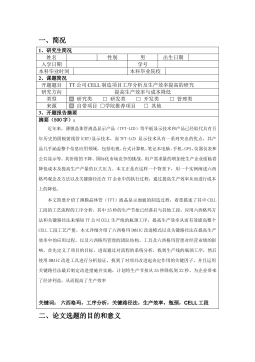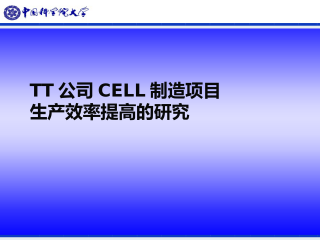Sector Throughput Using Frequency-and-Time Domain Channel-Dependent Packet
Scheduling with Channel Prediction in OFDMA Downlink Packet Radio Access
Yoshiaki Ofuji, Akihito Morimoto, Hiroyuki Atarashi, and Mamoru Sawahashi
IP Radio Network Development Department, NTT DoCoMo, Inc.
3-5 Hikari-no-oka Yokosuka-shi, Kanagawa-Ken, 239-8536 Japan
Abstract-This paper presents the throughput performance using frequency-and-
time domain channel-dependent packet scheduling and adaptive modulation
and coding (AMC) that exploit channel prediction in OFDMA packet radio
access based on system-level simulations with a multi-cell configuration. The
simulation results show that, for the full-queue traffic model without considering
the traffic types, by employing the channel prediction, the sector throughput
performance using 32 chunks (chunk bandwidth of 288 kHz) is improved by
approximately 15% compared to the case without using channel prediction for
the GSM Typical Urban channel model with the maximum Doppler frequency
of 55.5 Hz and a 10-MHz channel bandwidth. Furthermore, assuming the same
channel conditions, when the real-time(RT) traffic and non-real-time (NRT)
traffic models are taken into account, the user throughput performance of the
NRT users is improved by approximately 10 to 15% by employing channel
prediction compared to the case without using channel prediction. Therefore,
we show that the channel prediction is effective in improving the throughput
performance based on system-level evaluation, even when mixed- traffic models
are taken into account.
I. INTRODUCTION
Investigation on the long-term evolution of the UMTS Terrestrial Radio
Access (UTRA) and the UMTS Terrestrial Radio Access Network
(UTRAN) was initiated as a study item, i.e., Evolved UTRA and UTRAN,
in the 3rd Generation Partnership Project (3GPP) [1]. In this study item,
the UTRA radio interface mainly targets a channel bandwidth wider than
5 MHz. Furthermore, OFDM-based radio access is considered to be
promising as a downlink radio access scheme, since it is inherently robust
against time dispersion in a multipath fading channel. In the Evolved UTRA
and UTRAN, one of the most important requirements is to achieve high
spectrum efficiency. To achieve this, the application of packet scheduling
associated with the multi-user diversity effect is essential, in which multiple
users share the total channel bandwidth and the base station (BS) controls
the radio resource assignment to these users. Since an OFDM signal
comprises many sub-carriers in the frequency domain, the channel
bandwidth can be segmented into multiple frequency blocks, i.e., frequency
chunks. Then, the optimum frequency chunk allocation based on the channel
quality of each chunk (hereafter frequency-and-time domain channel-
dependent packet scheduling) [2],[3] is very beneficial to improving sector
throughput thanks to multi-user diversity in a frequency-selective
(multipath) fading channel. When frequency-and-time domain channel-
dependent packet scheduling is applied, each chunk is assigned to nearly
the best user who has the best channel quality represented as the received
signal-to-interference plus noise power ratio (SINR). Thus, packet decoding
error hardly occurs when the channel variation in the time domain is almost
constant. However, when the channel conditions vary more frequently
than the control loop delay of the packet scheduling, this large channel
variation causes decoding errors in the received packets. In such a situation
with time-varying channel fluctuations, channel prediction of each chunk
based on the channel quality information fed-back from the receiver can
mitigate the packet decoding errors [4].
Therefore, this paper presents the sector throughput performance using
frequency-and-time domain channel-dependent packet scheduling and
adaptive modulation and coding (AMC) that exploit channel prediction in
OFDMA packet radio access based on system-level simulations with a
multi-cell configuration. The combined effect of channel-dependent
scheduling with channel prediction, AMC, and hybrid ARQ was presented
in [4] assuming TDMA radio access with a single carrier. In [4], the potential
benefit of channel prediction in time-domain channel-dependent scheduling
was proven in a single-cell model assuming channel prediction error
following a lognormal distribution. Thus, in the current paper, we investigate
the effect of channel prediction in the frequency-and-time domain channel-
dependent scheduling in OFDMA radio access using more realistic models.
First, we investigate the effect of channel prediction in system-level
simulations using a three-sectored seven-cell configuration considering
distance-dependent path loss, shadowing variation, and instantaneous
multipath Rayleigh fading. Then, the influence of actual variations in inter-
cell interference is considered. Second, we actually estimate future channel
variation from the extrapolation of the M-th order polynomial, which is
generated by curve fitting employing the least square method (LSM). Third,
we apply packet scheduling criteria considering the delay requirement of
each traffic flow, the type of packet whether initially transmitted packet or
retransmitted packet, and the channel quality of each accessing user at
each chunk[5]. Note that we use the notation of channel-dependent
scheduling in the paper to emphasize the criterion of channel quality for
each accessing user at each chunk. Fourth, we consider the mixed traffic
conditions containing real-time (RT) traffic users and non-real-time (NRT)
traffic users following a VoIP traffic model and Web browsing traffic model,
respectively. The rest of the paper is organized as follows. We present the
channel prediction method in the frequency-and-time domain channel-
dependent scheduling and AMC in Section II. Next, Section III describes
the packed scheduling method assumed in the paper. Then, after describing
the simulation configuration in Section IV, Section V presents the simulation
results.
II. CHANNEL PREDICTION METHOD IN CHANNEL-DEPENDENT PACKET
SCHEDULING
Figure 1 illustrates the principle of channel prediction in with frequency-
and-time domain channel-dependent packet scheduling OFDMA packet
radio access. Packet scheduling has a control loop delay, which is defined
as the delay from the timing of the SINR measurement for the packet
scheduling to the timing of the reception of the corresponding scheduled
packet. Therefore, we apply the channel prediction method in order to
compensate for the estimation error in the measured received SINR caused
by the control loop delay of the packet scheduling. In the channel prediction,
we generate the M-th order polynomial by fitting the past instantaneous
received SINR samples at every transmission time interval (TTI) employing
the LSM. More specifically, the channel prediction method is expressed
by using the following equation. First, in order to generate the curve to fit
the instantaneous received SINR variation of the past measurements, we
assume the curve of the M-th order polynomials, )(
ˆn
tu , which is given by
∑
=
=M
m
m
nmn tatu
0
)(
ˆ. (1)
Figure 1. Channel prediction with frequency-and-time domain channel-
dependent scheduling.
Chunk 1
Chunk 2
Chunk 3
Chunk L
Frequency
Time
SINR
Measured SINR
Predicted SINR
TTI length Control loop delay of scheduling
Chunk 1
Chunk 2
Chunk 3
Chunk L
Frequency
Time
SINR
Measured SINR
Predicted SINR
TTI length Control loop delay of scheduling

 2024-10-14 24
2024-10-14 24
 2025-01-09 7
2025-01-09 7
 2025-01-09 10
2025-01-09 10
 2025-01-09 6
2025-01-09 6
 2025-01-09 7
2025-01-09 7
 2025-01-09 8
2025-01-09 8
 2025-01-09 7
2025-01-09 7
 2025-01-09 9
2025-01-09 9
 2025-01-09 7
2025-01-09 7
 2025-01-09 8
2025-01-09 8










